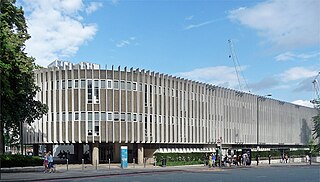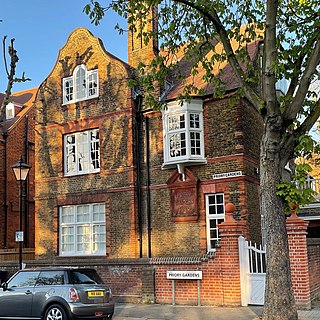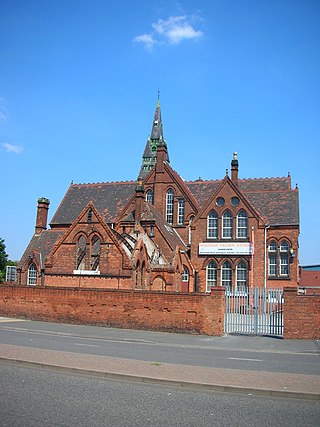
Wandsworth Town is a district of south London, within the London Borough of Wandsworth 4.2 miles (6.8 km) southwest of Charing Cross. The area is identified in the London Plan as one of 35 major centres in Greater London.

Swiss Cottage Library is a public library in the London Borough of Camden housed in an architectural landmark building on Avenue Road. Designed by Sir Basil Spence of Spence, Bonnington & Collins, it was built between 1963 and 1964.

Sheffield Old Town Hall is a building in Waingate in central Sheffield, South Yorkshire, England, opposite Castle Market. It is a Grade II listed building.

The Victorian Society is a UK charity and amenity society that campaigns to preserve and promote interest in Victorian and Edwardian architecture and heritage built between 1837 and 1914 in England and Wales. As a statutory consultee, by law it must be notified of any work to a listed building which involves any element of demolition or structural alteration.

Icknield Street School, near the Hockley Flyover, north of the Jewellery Quarter, Birmingham, England, is a good example of a Birmingham board school. It is owned by Birmingham City Council.

John Henry Price was the first person to hold the office of 'City Architect' in Manchester Corporation's newly created City Architect's Department of 1902. He was responsible for a number of well known Manchester landmarks, and is credited with influencing the design of other buildings constructed during his tenure, such as Manchester Fire Station.

Edwardian architecture usually means a Neo-Baroque architectural style that was popular for public buildings in the British Empire during the Edwardian era (1901–1910). Architecture up to 1914 is commonly included in this style.

The Carnegie Library is in Egerton Street, Runcorn, Cheshire, England. It is recorded in the National Heritage List for England as a designated Grade II listed building and "possesses special architectural and historic interest within a national context". It was built in 1906 as an extension to Waterloo House and the existing library with a grant from Andrew Carnegie, and closed in 2012.

The architecture of Liverpool is rooted in the city's development into a major port of the British Empire. It encompasses a variety of architectural styles of the past 300 years, while next to nothing remains of its medieval structures which would have dated back as far as the 13th century. Erected 1716–18, Bluecoat Chambers is supposed to be the oldest surviving building in central Liverpool.

The former Manchester Law Library at 14 Kennedy Street, Manchester, England, is a Grade II* listed building in the Venetian Gothic style. The building is notable as having housed the oldest provincial law library in England. Its architect, Thomas Hartas, is little known, and the former law library appears to be his only documented building. In 2015, the Manchester Incorporated Law Library Society sold the premises, and moved to new offices on Booth Street.
Sir Arnold Thornely was an English architect who practised in Liverpool. Although most of his designs were for buildings in Liverpool and the northwest of England, he is best known for the Parliament Buildings in Belfast, Northern Ireland. Thornely was knighted in 1932, and in the following year received the Bronze Medal of the Royal Institute of British Architects for Ulster.

Everton Library is a disused library building in Everton Brow, Liverpool. Designed by architect and Liverpool City Surveyor Thomas Shelmerdine and constructed in 1896, it remained in use as a library until 1999. It was used by various community groups up until 2006, and has been derelict since. There are plans in progress to convert the building for use as an arts, culture, heritage and enterprise centre. In September 2019, it was named on the Victorian Society's list of the top ten most endangered buildings in England and Wales.

The Carnegie Library is a public library in the London Borough of Lambeth in Herne Hill, South London. The library opened in 1906. It closed as a public lending library in 2016 as a result of cuts to funding, reopening in 2018 with a reduced librarian service.

County Buildings is a municipal facility at Martin Street in Stafford, Staffordshire. The building, which is the meeting place for both Staffordshire County Council and Stafford Borough Council, is a Grade II* listed building.

The Old Town Hall is a municipal building in Yorkshire Street, Oldham, England. It is a Grade II listed building.

The Borough Hall is a municipal building in Eastgate Street, Stafford, Staffordshire, England. The borough hall, which formed the headquarters of Stafford Borough Council, is a Grade II listed building.

Burslem Market Hall, built in 1879, is a listed building in the centre of Burslem, in Stoke-on-Trent, England. The former market hall was closed in 2003.

The Old Library is a building on Queen's Square in Wrexham city centre, Wales. Built as a carnegie library in 1907, the building served as Wrexham's public library until 1973, when it later became council offices. The building is Grade II listed and owned by Wrexham County Borough Council. It is proposed to be converted into a hub for creative arts.

Hove Library is a public lending library serving Hove, part of the English city of Brighton and Hove. The "highly inventive" Edwardian Baroque/Renaissance Revival-style building, a Carnegie library designed by the architects Percy Robinson and W. Alban Jones of Leeds, opened in 1908 on Church Road, succeeding a library founded in 1890 in a house on the nearby Grand Avenue. The building has been listed at Grade II by Historic England for its architectural and historical importance.



















